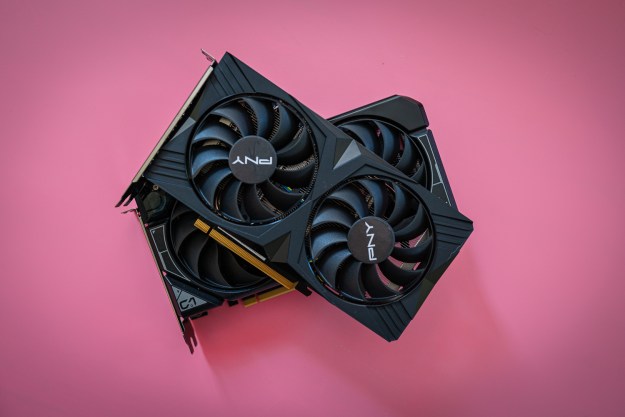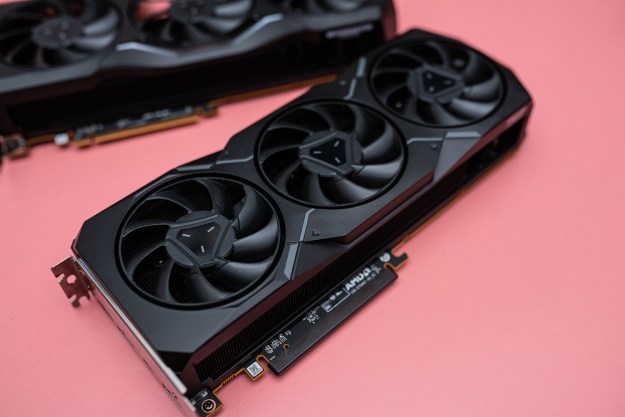AMD’s 5700 and 5700 XT changed a lot. Although Nvidia still dominates the market, AMD’s Navi architecture made the company at least competitive (a position it hasn’t been in for years). Between them, though, which should you pick?
There’s a lot going on with the 5700 and its XT variant, especially in 2021 as price and stock issues plague the GPU market. You may not be able to buy one, but AMD’s recent Big Navi cards provide a suitable replacement.
For a look at how these cards measure up to the competition from Nvidia, check out our original RX 5700 XT and 5700 review, and our head-to-head comparison with the Nvidia RTX 2060 Super.
Performance

The crux of this comparison was always going to be down to performance. The raw power of these two cards is their biggest differentiating factor, so the question is, should you spend extra money for the added capabilities of the 5700 XT?
Let’s take a look at the specifications first to see what divides these two cards:
| Radeon RX 5700 XT | Radeon RX 5700 | |
| Architecture | RDNA | RDNA |
| Compute units | 40 | 36 |
| Steam processors | 2,560 | 2,304 |
| Base clock | 1,605MHz | 1,465MHz |
| Game clock | 1,755MHz | 1,625MHz |
| Boost clock | 1,905MHz | 1,725MHz |
| Memory | 8GB GDDR6 | 8GB GDDR6 |
| Bandwidth | 448GBps | 448GBps |
| TDP | 225w | 180w |
| Price | $399 | $349 |
The first major difference is the number of compute units. The 5700 XT has just over 10% more with 40, versus the 5700’s 36. That equates to the same difference in stream processors and should be a major component in the differentiating performance between these two cards.
Another major difference is the clock speed. The base clock is 150MHz higher on the 5700 XT. Its “game clock” — the typical clock speed you can expect during sustained load — is 130MHz higher, which also aids the performance improvements over the 5700, though that gap can be closed with overclocking. The boost clock is much greater on the XT too, but unless you have strong cooling from a third-party card, it’s not a speed you’ll likely hit regularity.
The 5700 XT has a sizeable uplift in TDP requirements, making it a greater candidate for aftermarket cooling. Some buyers with high-end aftermarket cooling and tweaking have managed to push their cards well north of 2GHz on a sustained basis.
Finally, both cards have identical configurations of GDDR6 video memory and bandwidth.
As for how this all affects real-world performance, we turn to our suite of benchmarks that we conducted during our initial review of the two cards.
Both cards perform well in our 3DMark Time Spy test. The 5700 XT was able to keep level with the RTX 2060 Super and the Radeon VII, with the 5700 lagging behind by just over 10%. Considering it’s noticeably cheaper, that’s a fair result.
In gaming tests, both cards prove to be very capable at both 1080p and 1440p, with more than playable frame rates (40-80 fps) at 4K in Fortnite, Battlefield 5, and Civilization VI. Across the board, we see the RX 5700 perform within roughly 10% of the 5700 XT. In some cases, it’s even closer.
If you’re just looking for overall performance, the 5700 XT is clearly the better card. However, if value is important and the extra $50 would be more useful elsewhere, the 5700 holds its own. That’s especially true at 1440p, where it manages well over 100 fps in Civilization VI and close to it in Battlefield 5 and Fortnite.
In 2021, however, it’s not as simple as an extra $50. As of late February, the cheapest 5700 we could find was $1,150. A step up to the 5700 XT isn’t all that much more expensive — considering the absolutely insane price gouging that’s going on — clocking in at a modest $1,180.
If it wasn’t clear enough, these prices are ridiculous. Neither the 5700 nor the 5700 XT are worth the price of the few cards that are in stock. You’d be much better off tracking down one of AMD’s new Big Navi graphics cards: The 6800 or 6800 XT. These new cards are experiencing similar stock and pricing issues, but you still have a fighting chance at finding one around MSRP. That chance has passed for the 5700 and its XT variant.
Not only will one of the Big Navi cards be cheaper if you find one in stock, but it’ll also perform much better than AMD’s last-gen lineup.
Cooling and overclocking

One of the biggest issues facing the RX 5700 XT and 5700 at launch was that the reference blower coolers weren’t up to the task. They just aren’t great. They’re loud and they don’t cool the GPU well enough to prevent throttling, which is why, out of the box, many reference cards struggle to hit the speeds that AMD claimed. However, some owners have discovered that new heat paste and added washers can make quite a difference.
Fortunately, third-party variants are far more capable, delivering cooler and quieter cards, and unlocking far more impressive overclocking. In early testing after the cards’ release, IgorsLab overclocked a 5700XT to more than 2.1GHz on the core, leading to an 11% performance uplift in Shadow of the Tomb Raider. Others have pushed the card even further, seeing overclocks as high as 2.3GHz.
The 5700, on the other hand, is limited by AMD, so it can’t overclock to the same extremes right out of the box. IgorsLab hit a wall at 1,800MHz on the core with a 20% increase in power limit.
Fortunately, there are ways around that limit. A BIOS flash will give you all the same overclocking headroom as a 5700 XT, just without the additional four compute units. That means you can take a 5700 and make it as fast as a 5700 XT using the right cooling.
The 5700 brings the value
As a counter to Nvidia’s 20-series Super GPUs, the 5700 and 5700 XT were impressive cards. With Nvidia’s 30-series GPUs and AMD’s 6000-series, however, both cards are undoubtedly last-gen. Add on top of that the pricing and stock issues, and the 5700 range loses a lot of its luster.
There are a few things to consider when looking at last-gen cards. Gamers and modders frequently overclock them to get more from their performance. These GPUs can be hot and loud in stock configuration. If you know you’re going to overclock this type of GPU, consider adding a cooling solution.
You’ll get more power from the 5700 XT if you don’t modify the stock settings. It’s an excellent mid-range card for 1080p and 1440p. But if you overclock and don’t mind flashing its BIOS, the RX 5700 is the better and more affordable choice.
Either way, that route may not be feasible. However, there’s a strong possibility AMD won’t have these last-gen cards as its Big Navi range gains popularity. If you find one in stock for a good price, both cards work great. Whichever you can get your hands on would be a significant upgrade for those on older systems.
Editors' Recommendations
- Google Drive vs. Dropbox: which is best in 2024?
- 10 best graphics cards of 2024: finding the best GPU for gaming
- The best processors in 2024: AMD and Intel CPUs duke it out
- The Nvidia RTX 4080 Super just trounced AMD
- This underrated AMD GPU beats the RTX 4070 Ti Super





